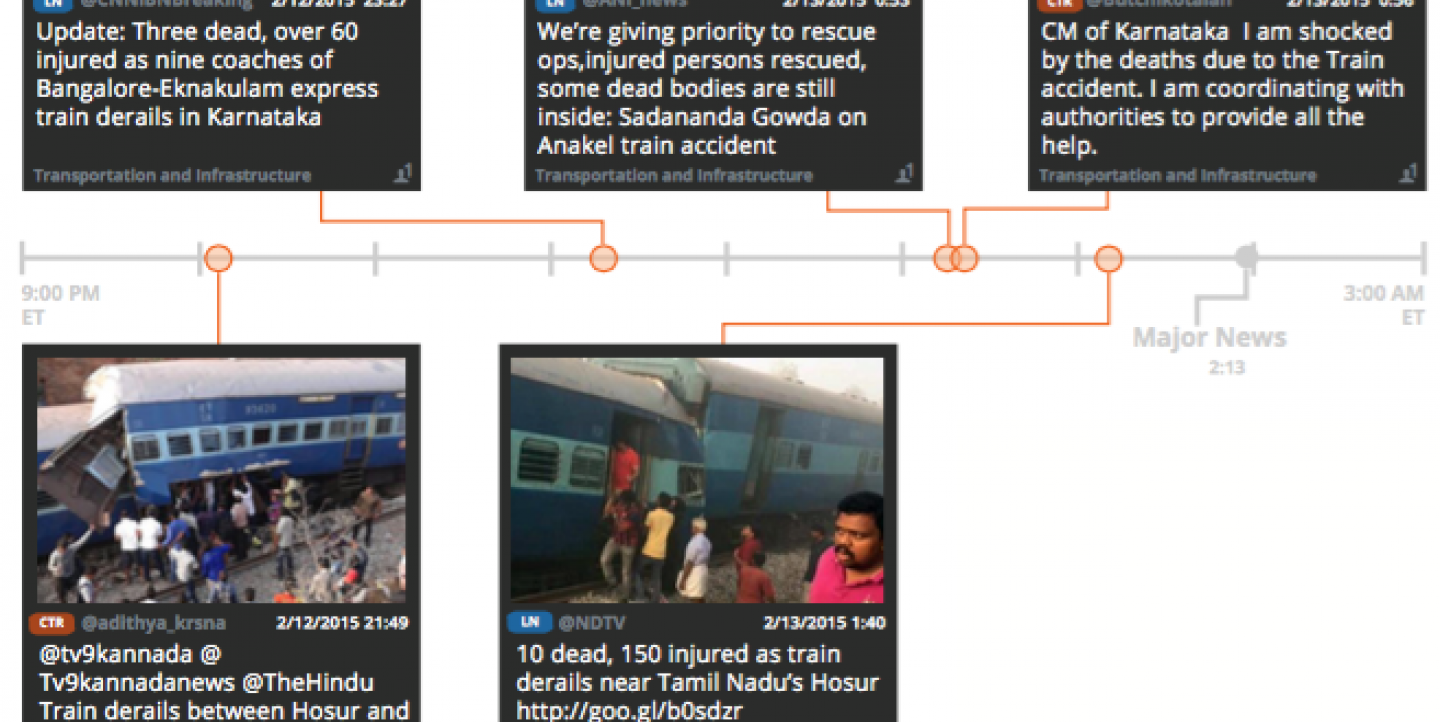In February this year, an express train crash near Bangalore killed 10 passengers and injured over 150 others. News alerts from national publishers and broadcasters began trickling in as text-only tweets a few minutes before 9 a.m. IST. But these weren’t the first tweets about the accident. Local users had already been posting details and images from the site for more than an hour and a half. Information discovery platform Dataminr alerted us to these at 7:19 a.m. -- with a status message and photo -- within minutes of the crash and way ahead of traditional news sources, including wires.
Dataminr sifts through real-time tweets and other publicly available datasets for the latest news. Dataminr’s timeline for the Hosur train crash story showed how the event developed on Twitter, with input from users, wires and news outlets.
Inspired by these other case studies, New Delhi's Hindustan Times (HT) newsroom, where I'm working as part of my ICFJ Knight Fellowship, has been tinkering with Dataminr for four months now. There have been hits but also misses. Driving the adoption of signals-driven editorial planning in a legacy print newsroom is a landmine of challenges in terms of training, culture and workflows. Still, the tool is increasingly becoming a go-to source of leads for HT’s journalists, alongside wire feeds, TV news tickers and social search. Here’s how we have been using the dashboard so far:
1. For early warnings on breaking/trending stories
Late at night on April 1, a former finance minister was rushed to the intensive care unit at the army’s hospital in Delhi. HT’s editor-in-chief saw the alert on Dataminr’s mobile app at home and flagged it to the newsdesk staff — who are always glued to wires and usually the first to discover such leads. This story was up before midnight, while most other newsrooms carried wire copy the next day.

The system also alerts us to stories whose social behaviour indicates that they might soon trend or go viral. The Momentum alert below helped us get onto this Kashmir story early.
Momentum alerts on Dataminr help identify stories with growth potential, before they start trending.
2. For first pics, videos, quotes around a developing story
In June, when the Taliban bombed Afghanistan’s parliament, HT had visuals before or at par with international wires. Dataminr’s image search was picking up everything being shared by local news sources, including Afghan parliament member Naqibullah Faiq’s photo from inside the building.
And on day of this year’s first Nepal earthquake, we were able to track down some very compelling images from the ground to create before/after media like this.
Images by @SiobhanHeanue.
3. For hyperlocal alerts that would otherwise be missed
Dataminr’s been working with global newsrooms like CNN and BBC for over a year. At this point, their algorithm is clearly at the top of its game when tracking international news. The true test is when it’s used to monitor news from the most interior regions, especially in the global South and East. By the product team’s own admission, they are not there yet. But once in a while, a remote story comes through.
An example of a hyperlocal alert from Dataminr.
Dataminr alerted us to this city blog’s tweet from northeast India, and Google showed that we were at least six hours ahead of the major national or regional news outlets.
4. For identifying and contacting on-the-ground sources
A few months ago, a major sandstorm in the Middle East extended as far as India’s western coast. It wasn’t a major story for our market, but out of curiosity, we searched the Dataminr map to get a sense of what it was like on the ground in the state of Rajasthan. We found a group of city folk and tourists had gone all the way out into the desert for — wait for it — an auto-rickshaw race! This Vine captures a person on an open motor vehicle being chased by rickshaws during the race.
HT picked up these posts for a Storify-style human interest piece, but more importantly, our social media producer was able to message one of these racers for better pics.
What's next?
There’s a lot more to the dashboard, especially the map and graph search. HT doesn’t have a case study for those yet, but if your newsroom uses Dataminr too, we would love to learn from your experience.
Nasr ul Hadi works with media organizations in India to improve access to quality information and journalism, by developing and expanding the use of new technologies and digital-led best practices. Learn more about his work as an ICFJ Knight Fellow here.
Main screenshot of Dataminr timeline courtesy of Garrett Santora of the Dataminr product team and other images provided by Hadi.

